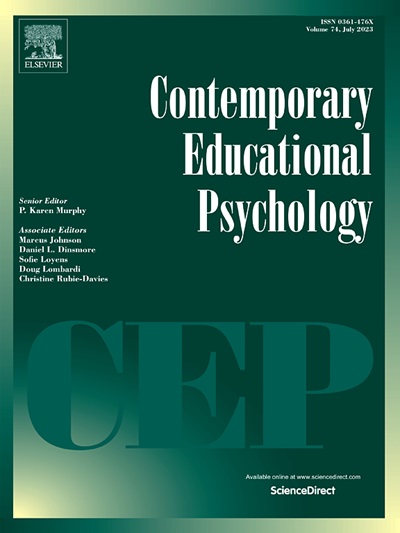Using an observational measure of elementary teachers’ emotional expressions during mathematics and English language arts to explore associations with students’ content area emotions and engagement
IF 3.8
1区 心理学
Q1 PSYCHOLOGY, EDUCATIONAL
引用次数: 0
Abstract
Processes of classroom emotional transmission have been identified whereby the emotions expressed by an individual are induced in others, with particular attention paid to how this unfolds among teachers and their students. However, there is still much to be clarified about how teachers’ and students’ emotions transmit in the classroom, including the extent to which the teachers’ observable emotional expressions are meaningful for students’ learning experiences and the potential context-specificity of these associations. In the present study, we introduce the Teacher Affect Coding System (TACS), a new observational measure of teachers’ emotional expressions and use data from this measure to describe the factor structure and nature of these emotional expressions as teachers instruct in mathematics and English language arts (ELA). We then use TACS data in combination with students’ self-reports of their content area enjoyment, anxiety, and behavioral engagement to conduct an exploratory analysis of the associations among teachers’ expressions and their students’ learning-related emotions and behaviors in each content area. Participants included 65 fourth-grade teachers and 805 students recruited from a Southwestern U.S. state. Confirmatory factor analyses revealed four factors differentiating between positive and negative emotions in each content area. Descriptive analyses indicated that teachers displayed more positive emotions than negative, and that emotional expressions were fairly consistent across content areas. Path analyses revealed that teachers’ negative emotional expressions in ELA were associated with reduced student ELA enjoyment and engagement, and negative emotional expressions in mathematics were associated with reduced student mathematics engagement. Findings speak to the importance of teacher training and professional learning opportunities focusing on emotional regulation skills among elementary teachers.
通过对小学教师在数学和英语语言艺术课上的情绪表达的观察,探讨其与学生内容领域情绪和参与的关系
课堂情绪传递的过程已经被确定,即一个人表达的情绪在其他人身上被诱导,特别关注这种情绪如何在教师和学生之间展开。然而,关于教师和学生的情绪是如何在课堂上传递的,包括教师可观察到的情绪表达对学生的学习经历有多大意义,以及这些联系的潜在情境特异性,还有很多需要澄清的地方。在本研究中,我们引入了一种新的教师情绪表达观察量表——教师情绪编码系统(TACS),并利用该量表的数据来描述教师在进行数学和英语语言艺术(ELA)教学时情绪表达的因素结构和性质。然后,我们使用TACS数据结合学生对其内容领域的享受、焦虑和行为参与的自我报告,对教师的表达与学生在每个内容领域的学习相关情绪和行为之间的关联进行了探索性分析。参与者包括从美国西南部一个州招募的65名四年级教师和805名学生。验证性因子分析揭示了在每个内容区域中区分积极和消极情绪的四个因素。描述性分析表明,教师表现出的积极情绪多于消极情绪,并且情绪表达在各个内容领域相当一致。通径分析显示,教师消极的ELA情绪表达与学生的ELA享受度和投入度降低有关,而数学消极的情绪表达与学生的数学投入度降低有关。研究结果说明了教师培训和专业学习机会对小学教师情绪调节技能的重要性。
本文章由计算机程序翻译,如有差异,请以英文原文为准。
求助全文
约1分钟内获得全文
求助全文
来源期刊

Contemporary Educational Psychology
PSYCHOLOGY, EDUCATIONAL-
CiteScore
16.50
自引率
3.90%
发文量
74
期刊介绍:
Contemporary Educational Psychology is a scholarly journal that publishes empirical research from various parts of the world. The research aims to substantially advance, extend, or re-envision the ongoing discourse in educational psychology research and practice. To be considered for publication, manuscripts must be well-grounded in a comprehensive theoretical and empirical framework. This framework should raise critical and timely questions that educational psychology currently faces. Additionally, the questions asked should be closely related to the chosen methodological approach, and the authors should provide actionable implications for education research and practice. The journal seeks to publish manuscripts that offer cutting-edge theoretical and methodological perspectives on critical and timely education questions.
The journal is abstracted and indexed in various databases, including Contents Pages in Education, Australian Educational Index, Current Contents, EBSCOhost, Education Index, ERA, PsycINFO, Sociology of Education Abstracts, PubMed/Medline, BIOSIS Previews, and others.
 求助内容:
求助内容: 应助结果提醒方式:
应助结果提醒方式:


